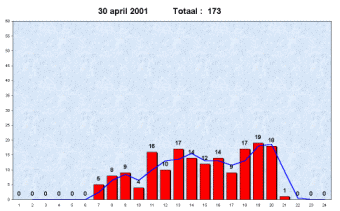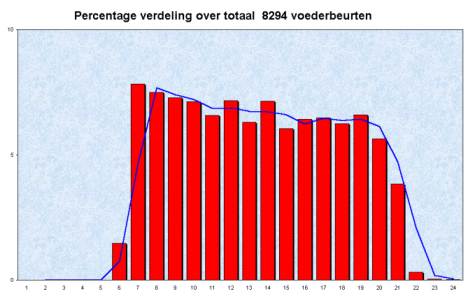
 |
|
By means of an electronic counter connected to
an old computer the times and time were registered that a bird flew in and
out of a nest box.
The birds are registered entering and leaving the nest-box. This would mean that the registrered data are approximately twice as high as the nestlings are tended by the parents. Because of the accuracy of the counter a lower bound of 4 seconds in the registration was necessary. This avoided a lengthy file filled with data only hundreds of a second apart. |
But bluntly dividing the registrered data in two to get the correct registration of visits would result in another deviation of the truth. During the nestling period the time spent in the box reduces all the time. At first both parents will enter the nest box and leave in about 35 to 30 seconds. Later on the opposite occurs namely they stay out of the nest-box about 35 to 30 seconds. At the end the parents will not enter the box itself at all. To adjust this variation in behaviour we introduced a threshold value that would vary with time.
Improvements both in the approach and in the programmes will make the conclusions more reliable.
|
|
Here you can see some results.
The figure shows the number of visits by the
parents. The first brood (5 nestlings) shows a great difference with the second brood (3 nestlings). The
first brood has a higher frequency in feedings.
|
 |
 |
We
calculated the feedings per hour as a percentage of the total number of
feedings.
Now the difference of the first brood
with the second brood becomes more clear. The number of feedings during the hottest
time of day are less in the second brood. This is compensated by the
number of evening and night feedings.
|
If someone has a fair idea about what improvements can be made with this approach. I will be grateful in receiving this information.
|
|